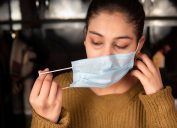Dangerous Fungal Infection Spreading to New Parts of U.S., CDC Warns
The potentially deadly spores may be causing more cases of blastomycosis than the agency realized.

During the winter, any signs of an oncoming cough are usually associated with the onset of a virus like COVID-19, the flu, or RSV. But in addition to the typical seasonal microbial foes, there are other types of respiratory illnesses that can make us seriously sick, and they're not as well known. Now, the Centers for Disease Control and Prevention (CDC) is warning that a dangerous fungal infection is spreading to new parts of the U.S. Read on to see which places are affected and what it could mean for you.
RELATED: CDC Issues New Warning to "Stay Alert" Amid Rising Measles Cases.
Blastomycosis is a respiratory infection caused by breathing in spores.

While we associate most respiratory infections with viruses and bacteria, they're not the only microorganisms that can make us sick. Blastomyces is a type of mold found in nature where there is plenty of damp soil or decomposing wood and leaves, according to the CDC.
Humans or animals that disturb areas where it's growing can release its microscopic fungal spores into the air, which they then breathe into their lungs. The increased temperature inside the body then allows the spores to turn into yeast, creating a fungal infection known as blastomycosis, per the CDC. In severe cases, the yeast can spread to other parts of the body, including the skin, bones, vital organs, and the central nervous system.
Unfortunately, research shows the fungus can be pretty dangerous. According to a CDC study, hospitalization rates for symptomatic patients can range from 57 to 69 percent, and death rates can range from 4 to 22 percent.
RELATED: COVID Now Causing These Unusual Symptoms, New Data Shows.
The rare illness was previously believed to be confined to a few states.

Reported cases of blastomycosis remain relatively rare in the U.S., with roughly a little less than two per 100,000 people annually, per CDC data. But the agency points out that the fungus is also somewhat geographically limited, with a natural range that includes the midwest, the Mississippi River and Ohio River valleys, the Great Lakes, and the St. Lawrence River.
To date, Wisconsin is the state with the most reported cases, with anywhere from 10 to 40 annual cases per 100,000 people each year—especially among the most northern counties, according to the CDC. The limited range means that Arkansas, Louisiana, Michigan, Minnesota, and Wisconsin are the only states where health departments actively monitor for the illness. Missouri, Mississippi, and Illinois all also reported cases between 1978 and 2017.
RELATED: Salmonella Outbreak Spreading in 22 States—These Are the Symptoms.
A new study shows that more infections are popping up in new places in the U.S.

However, new data shows that the fungal infection may be expanding its territory. In a study published in the Feb. 2024 edition of the CDC's journal Emerging Infectious Diseases, a team of researchers analyzed health insurance claims in Vermont from 2011 to 2020 to help pinpoint diagnosed cases of blastomycosis. Results showed that the state saw a rate of 1.8 patients per 100,000 people over the time frame, making it the second highest of any state besides Wisconsin.
"Our findings…align with a growing body of evidence suggesting that the burden of endemic blastomycosis is greater than commonly appreciated," the study authors wrote in their conclusion. They added that the results "challenge routine assumptions" about the infection and warrant future studies to understand the disease better.
The study team also pointed out some other commonalities in the data, including that the three counties that saw the most blastomycosis in Vermont were also the state's most northern. This could also suggest that Blastomyces might be more far-reaching than the medical community realizes.
"This disease is probably more common in Vermont than was previously thought and perhaps in other states as well," Brian Borah, MD, medical director for Vaccine-Preventable Diseases Surveillance at the Chicago Department of Public Health and lead author of the latest study, told USA Today. "I think it's important that clinicians be aware and to have this diagnosis in their list of possibilities when they're seeing patients."
The symptoms of blastomycosis can make it difficult to diagnose.

According to the CDC, symptoms of blastomycosis can develop between three weeks and three months after a patient has inhaled the spores. Many are similar to what people experience with a common cold or the flu, including fever, cough, shortness of breath, night sweats, and muscle aches or joint pain. Others can experience weight loss, extreme fatigue, and chest, rib, or back pain. However, signs of infection might also develop into something more serious.
"Some of the other less common presentations include skin manifestations, so people can have skin lesions. More rarely, patients can have lesions within their bones. The infection can sometimes even involve the central nervous system or the brain," Borah told USA Today. "While this is a rare disease, and some people don't have any symptoms, it can still be a fatal disease. There are still people that die from this disease every year."
Blastomycosis patients can be treated with anti-fungal medications. However, doctors say that since infection is relatively rare and similar to pneumonia, it's not uncommon to be misdiagnosed at first. And while initial infections may come about through breathing in the invisible fungal spores, the disease isn't contagious.
"The fungus is not spread from animal to person, person to animal, or person to person," Suzanne Gibbons-Burgener, MD, infectious disease epidemiologist at the Wisconsin Department of Health Services, told USA Today.
Best Life offers the most up-to-date information from top experts, new research, and health agencies, but our content is not meant to be a substitute for professional guidance. When it comes to the medication you're taking or any other health questions you have, always consult your healthcare provider directly.





















